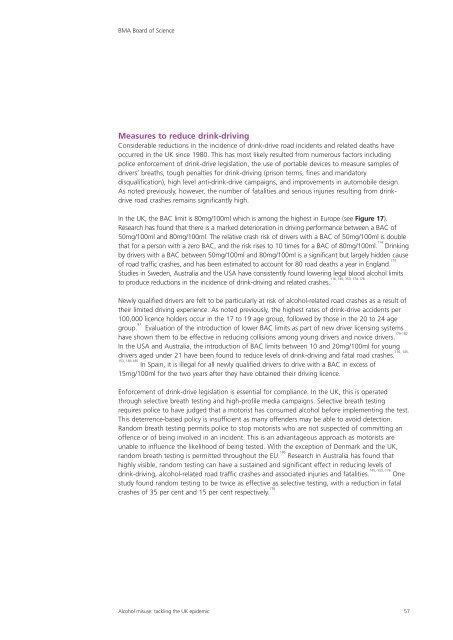Alcohol misuse: tackling the UK epidemic - London
Alcohol misuse: tackling the UK epidemic - London
Alcohol misuse: tackling the UK epidemic - London
Create successful ePaper yourself
Turn your PDF publications into a flip-book with our unique Google optimized e-Paper software.
BMA Board of Science<br />
Measures to reduce drink-driving<br />
Considerable reductions in <strong>the</strong> incidence of drink-drive road incidents and related deaths have<br />
occurred in <strong>the</strong> <strong>UK</strong> since 1980. This has most likely resulted from numerous factors including<br />
police enforcement of drink-drive legislation, <strong>the</strong> use of portable devices to measure samples of<br />
drivers’ breaths, tough penalties for drink-driving (prison terms, fines and mandatory<br />
disqualification), high level anti-drink-drive campaigns, and improvements in automobile design.<br />
As noted previously, however, <strong>the</strong> number of fatalities and serious injuries resulting from drinkdrive<br />
road crashes remains significantly high.<br />
In <strong>the</strong> <strong>UK</strong>, <strong>the</strong> BAC limit is 80mg/100ml which is among <strong>the</strong> highest in Europe (see Figure 17).<br />
Research has found that <strong>the</strong>re is a marked deterioration in driving performance between a BAC of<br />
50mg/100ml and 80mg/100ml. The relative crash risk of drivers with a BAC of 50mg/100ml is double<br />
that for a person with a zero BAC, and <strong>the</strong> risk rises to 10 times for a BAC of 80mg/100ml. 114<br />
Drinking<br />
by drivers with a BAC between 50mg/100ml and 80mg/100ml is a significant but largely hidden cause<br />
of road traffic crashes, and has been estimated to account for 80 road deaths a year in England. 173<br />
Studies in Sweden, Australia and <strong>the</strong> USA have consistently found lowering legal blood alcohol limits<br />
116, 145, 153, 174-178<br />
to produce reductions in <strong>the</strong> incidence of drink-driving and related crashes.<br />
Newly qualified drivers are felt to be particularly at risk of alcohol-related road crashes as a result of<br />
<strong>the</strong>ir limited driving experience. As noted previously, <strong>the</strong> highest rates of drink-drive accidents per<br />
100,000 licence holders occur in <strong>the</strong> 17 to 19 age group, followed by those in <strong>the</strong> 20 to 24 age<br />
group. 97<br />
Evaluation of <strong>the</strong> introduction of lower BAC limits as part of new driver licensing systems<br />
have shown <strong>the</strong>m to be effective in reducing collisions among young drivers and novice drivers. 179-182<br />
In <strong>the</strong> USA and Australia, <strong>the</strong> introduction of BAC limits between 10 and 20mg/100ml for young<br />
116, 145,<br />
drivers aged under 21 have been found to reduce levels of drink-driving and fatal road crashes.<br />
153, 183-185<br />
In Spain, it is illegal for all newly qualified drivers to drive with a BAC in excess of<br />
15mg/100ml for <strong>the</strong> two years after <strong>the</strong>y have obtained <strong>the</strong>ir driving licence.<br />
Enforcement of drink-drive legislation is essential for compliance. In <strong>the</strong> <strong>UK</strong>, this is operated<br />
through selective breath testing and high-profile media campaigns. Selective breath testing<br />
requires police to have judged that a motorist has consumed alcohol before implementing <strong>the</strong> test.<br />
This deterrence-based policy is insufficient as many offenders may be able to avoid detection.<br />
Random breath testing permits police to stop motorists who are not suspected of committing an<br />
offence or of being involved in an incident. This is an advantageous approach as motorists are<br />
unable to influence <strong>the</strong> likelihood of being tested. With <strong>the</strong> exception of Denmark and <strong>the</strong> <strong>UK</strong>,<br />
random breath testing is permitted throughout <strong>the</strong> EU. 186<br />
Research in Australia has found that<br />
highly visible, random testing can have a sustained and significant effect in reducing levels of<br />
145, 153, 176<br />
drink-driving, alcohol-related road traffic crashes and associated injuries and fatalities. One<br />
study found random testing to be twice as effective as selective testing, with a reduction in fatal<br />
crashes of 35 per cent and 15 per cent respectively. 176<br />
<strong>Alcohol</strong> <strong>misuse</strong>: <strong>tackling</strong> <strong>the</strong> <strong>UK</strong> <strong>epidemic</strong> 57
















